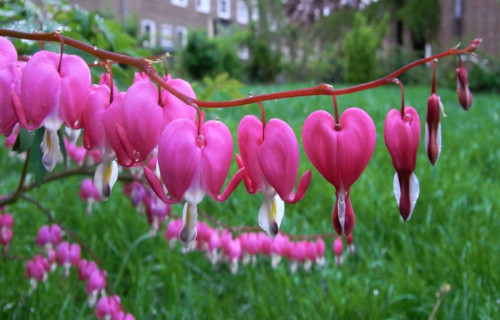
CCL: https://bit.ly/2x25vsC
We honestly hope that you thoroughly enjoy reading this article about 6 Wondrous Woody Shrubs of Asia. Without doubt, we enjoyed creating it for you. These works of Nature remain some of the most amazing plants of their kind found anywhere in the world.
Obviously, though, these few contained herein represent only a small fraction of the similar species found in this part of the world. But, we hope that they are enough to foster in you a hunger to learn more. So, read on, and see what you can discover.
Jade Vine
Jade Vine Facts
- Leading off this article about 6 Wondrous Woody Shrubs of Asia is the breathtaking plant known as the Jade Vine.
- Its highly unique nature ranks as the most noteworthy fact about the gorgeous Jade Vine. The beauty of this plant conceals the point that it’s actually a legume. Botanists list them as closely related to beans such as the runner bean and kidney bean.
- While the seed pods of the species remain technically edible, the plant is not for consumption. It does have other uses, though. That’s true because of the sheer beauty of the flowers it produces. Cultivators grow it mostly as an ornamental species.
- For now, the IUCN does not have a classification of the species on its Red List of Threatened Species. But, experts consider it endangered due to its limited range and the threats it faces. These primarily include habitat loss and climate change.
- The species has another unusual distinction, separating it from related species. Unlike the majority of plants, a specific bat species forms the primary pollination of this species. Certain butterfly species also play a small role in its pollination, however.
Jade Vine Physical Description
The bright and beautiful Jade Vine grows as a perennial vine. Plus, the remarkable plant also has a fascinating trait. That holds true due to the fact that it doubles as a legume. The strong and fast-growing vines can attain lengths of as much as 59 ft (18 m).
The impressively resourceful plant also clings to and climbs on virtually anything it encounters. This source of support primarily consists of trees within its native environment. The leaves of the vine have a pale green color and consist of three leaflets.
When these leaves fall, a surprising transformation takes place. This holds true due to the fact that at that time, these turn to either a dark blue or purple in color. The seed pods of the Jade Vine rarely exceed 6 in (15 cm) in length. These features often contain up to 15 seeds.
Yet the flowers of this visually stunning plant understandably garner the most attention. That’s partly because the claw-shaped blooms hang in trusses consisting of as many as 75 flowers. These remarkable trusses can reach lengths of as much as 9.8 ft (3 m).
- Kingdom: Plantae
- Phylum: Angiosperms
- Order: Fabales
- Family: Fabaceae
- Genus: Strongylodon
- Species: S. macrobotrys
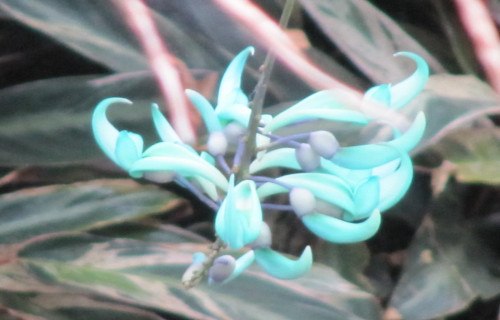
CCL: https://bit.ly/2WAJj2B
Jade Vine Distribution, Habitat, and Ecology
Since the stunning Jade Vine grows natively only in the Philippines, its habitat is quite restricted. Even there specimens only occur in regions of montane and tropical forests. It appears most often beside streams or in ravines, the latter for unknown reasons.
This amazing species has also been transplanted to a few other regions of the world. This artificial distribution most notably includes the country of South Africa. The species further has a strong presence in greenhouses and botanical gardens worldwide.
Its unique pollination relationship with bats arose due to a very specific reason. This occurred as a result of the shape of its distinctive blooms. The vines also generally intertwine themselves along the branches and trunks of trees, creating a network.
A mature vine of this species requires about two years to flower and produce fruit. Most commonly, the plant amazing grows prolifically in its native habitat. Unfortunately for those who attempt to grow it, it remains difficult to propagate in cultivation.
Scythian Lamb
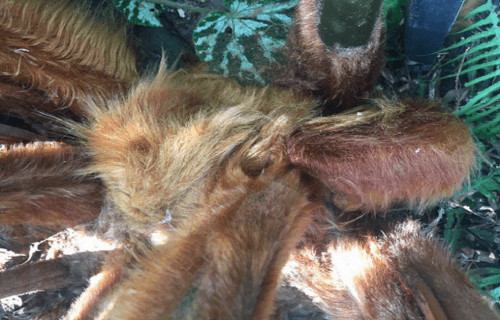
Scythian Lamb Facts
- Our second choice for inclusion in this article about 6 Wondrous Woody Shrubs of Asia is the amazing Scythian Lamb.
- The incredible flora presents a remarkable appearance to all who see it. Further, the incredible plant has its own footnote in history. This occurred because some ancient peoples believed the distinctive plant actually produced sheep.
- But, this unusual species does have very useful properties. In fact, it has chemical properties which give it legitimate medicinal uses. This plant remains a common ingredient in folk medicine even today, within its native habitat range.
- The Scythian Lamb has a broad endemic range, compared to related species. Despite this, its numbers continue to decline. This trend appears to be primarily due to its being extensively collected throughout much of its endemic range.
- It should be noted that another deceptive characteristic of the plant also exist. Despite its low-slung stature, this distinctive species actually belongs to the tree fern family. As a result, as remains true of many tree ferns, it also tends to develop in colonies.
Scythian Lamb Physical Description
Not surprisingly, given its common name, the Scythian Lamb possesses a quite unusual nature. It also has a somewhat unique stature for a tree fern. That holds true due to the fact that this species only attains an average height of 3.25 ft (1 m) when erect.
However, the fascinating variety flora typically remains prostrate. In addition, the fronds of the remarkable fern typically grow to lengths of 10 ft (3 m). These astounding fronds of the Scythian Lamb most commonly develop a light green color.
But, the rhizomes of the species garner the most interest. This part of the plant evolved a covering of long, golden colored hairs resembling sheep’s wool. This also grows extremely thick in nature. The evergreen fern grows slowly, and typically in alkali-rich soils.
- Kingdom: Plantae
- Phylum: Tracheophytes
- Class: Polypodiopsida
- Order: Cyatheales
- Family: Dicksoniaceae
- Genus: Cibotium
- Species: C. barometz
Scythian Lamb Distribution, Habitat, and Ecology
Much like many of its related species, the fabulous Scythian Lamb evolved in a very specific type of region. In point of fact, the truly fascinating flora possesses a tropical and subtropical distribution. But, the plant primarily occurs endemically in the country of China.
Yet, the astounding fern also occurs in smaller numbers across much of the continent of Asia. Plus, the species also now appears elsewhere around the world. Its popularity has caused it to be introduced to several other regions, usually as a variety of ornamental plant.
It usually appears in gullies, forests, and on hillsides, and prefers areas of damp, shady conditions. It only grows naturally at altitudes between 656-15,146 ft (200-1,500 m). China, where most of the species still appears, banned the export the of the Scythian Lamb.
This fortunate action occurred in the year 1977. At that time, government officials took the action due to a marked decrease in its numbers. But sadly, the species continues to be heavily harvested in portions of southeast Asia for local medicinal uses.
Bleeding Heart

CC: https://bit.ly/2x25vsC
Bleeding Heart Facts
- Appearing third on this list of 6 Wondrous Woody Shrubs of Asia, though only due to random selection, is the awesome Bleeding Heart.
- Justifiably, the distinctive term serves as the attention-grabbing common name for a truly beautiful species of flowering plant. Its scientific name, though, remains the somewhat difficult to pronounce Lamprocapnos spectabilis.
- But the gorgeous plant also goes by variations of the common name. The most used of these remains the Asian bleeding-heart. Perhaps to the surprise of many of those who appreciate its great beauty, this marvelous plant also conceals a secret.
- That’s the fact that it’s a member of the poppy family. Because of its appearance, this plant has a high value in gardens and also in the floral industry. This holds true due to the delicate heart-shaped pink and white flowers it usually produces.
- The breathtaking Bleeding Heart quickly became spread to many parts of the globe. In fact, it made its first appearance in Europe in the 1840’s. Partly due to this artificial dispersal, the species appears to be stable and in abundance.
- The IUCN therefore currently has no listing for the plant on its Red List of Threatened Species. It could nevertheless be considered to be facing several potential dangers. The worst of these is likely the threat of climate change, as other species.
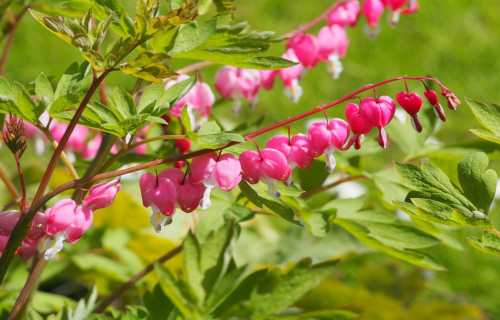
Bleeding Heart Physical Description
Among its numerous other characteristics, the Bleeding Heart also attains a respectable size. That’s due to the fact that the plant typically attains a height of around 47 in (120 cm). Plus, the average width of the plant generally averages a total of about 18 in (45 cm).
Regardless of its other marvels, however, the fantastic plant in fact shares many of the basic traits of related species. For one, this visually distinctive species also evolved into a herbaceous perennial. The delicate leaves further possess three lobes only.
The stems of the beautiful perennial, meanwhile, most commonly appear as either light green or pinkish in color. Each of the hanging stems of the Bleeding Heart produces as many as 20 blooms. These appear from early Spring through Summer.
Not to be outdone, the outer petals of the delicate bloom display a bright pink to light red color. However, the inner petals generally a bright show white. As the name implies, the flowers themselves form in the conventionalized shape of a heart.
- Kingdom: Plantae
- Phylum: Tracheophytes
- Class: Angiosperms
- Order: Ranunculales
- Family: Papaveraceae
- Genus: Lamprocapnos
- Species: L. spectabilis
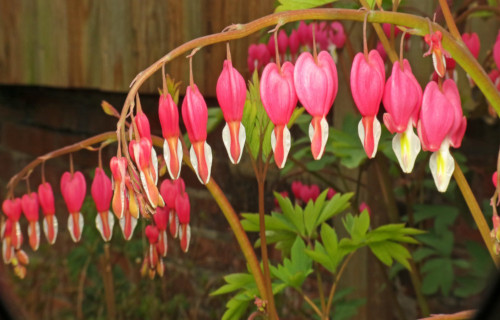
CCL: https://bit.ly/3dSHvZB
Bleeding Heart Distribution, Habitat, and Ecology
Though it now appears throughout the world, the Bleeding Heart evolved as endemic to a specific portion of the globe. That consisted solely of the continent of Asia. Specifically, the species appears naturally in portions of Siberia, northern China, Korea, and Japan.
In its natural range, the plant appears in the wild only in certain regions. These consist of areas of open forest with medium shade. These regions must also provide it with sufficient protection from the wind. But, in cultivation, it has proven itself to be adaptable.
The stunning plant known as the Bleeding Heart additionally plays an important role within its native range. That holds true because a wide variety of insects routinely feed on the leaves. Understandably, this sometimes makes the plant difficult to cultivate.
Creatures such as snails, slugs, and aphids appear to be the most common among these threats. The species also produces its seeds within long, relatively thin pods. During the Summer, the remarkable plant typically dies back, leaving only the root system.
Finally, it did manage to evolve a method of self-defense. That’s because the leaves and stem of the plant contain a variety of alkaloids. But, these are not considered dangerous. Contact with the plant generally produces only mild skin irritations.
Telegraph Plant
Telegraph Plant Facts
- Next up on the roster in this article about 6 Wondrous Woody Shrubs of Asia comes the fascinating Telegraph Plant.
- The unique term perfectly serves as the name given to a remarkable and impressive species. The unique plant also bears the cumbersome scientific name of Codariocalyx motorius. By any name, it remains an extremely fascinating type of flora.
- The Latin term motorius, which forms part of its hard to pronounce scientific name, also springs from a particular physical ability. That’s because it also represents one of the few known plants possessing a remarkable ability.
- That’s due to the fact that it’s capable of comparatively rapid movement. In yet another astounding gift from Nature, however, the leaves also move to follow the sun. It does this in order to maximize its use of the sun’s rays.
- Individual specimens also have the amazing ability to move comparatively quickly. Its ability to move with the sun has led to its being commonly used in gardening. It also holds a place of honor in science for another reason.
- That holds true due to the fact that Charles Darwin himself became the first person to describe the Telegraph Plant. This occurred in a scientific publication in 1880. Since it fortunately appears to have a stable population, the IUCN has no listing for it.
Telegraph Plant Physical Description
Doubtless, the most memorable physical feature of the Telegraph Plant is its remarkable leaflets. In point of fact, its best known for the astonishing movement of this incredible foliage. In addition to their ability to move, these develop as small and laterally shaped.
These appear in large numbers. Plus, the ability of this flora to move follows certain patterns. During the day the foliage commonly moves rapidly enough to be seen with the eye. The closure time measures 3-5 minutes, and happens due to its desire to follow the sun.
The small flowers of the Telegraph Plant also develop numerous in number. These appear a bright purple in color. This plant also produces large quantities of compounds known as tryptamine alkaloids. These chemicals develop primarily in its leaves and roots.
- Kingdom: Plantae
- Phylum: Angiosperms
- Class: Eudicots
- Order: Fabales
- Family: Fabaceae
- Genus: Codariocalyx
- Species: C. motorius
Telegraph Plant Distribution, Habitat, and Ecology
It perhaps comes a no great surprise that the incredible Telegraph Plant evolved as native to an area already renowned for its botanical diversity. That’s because this bewildering plant originates within the region of the world now known as tropical Asia.
In fact, the highly unique flora actually appears naturally across a comparatively wide swathe of the continent. Not only that, though, but the portions of the continent in which the marvel of Nature occurs naturally includes numerous countries.
Primarily, this includes the countries of Bangladesh, Cambodia, Bhutan, China, India, and Thailand. The impressive species also lives in one particular portion of the remote South Pacific. There, it appears naturally on the chain of islands named the Society Islands.
Given the region of the globe in which this remarkable plant evolved, the endemic habitat of the amazing Telegraph Plant comes as no surprise. That’s due to the fact that its native habitat consists primarily of rainforest, so common to this area.
However, even within that environment, it stands out. In point of fact, its requirements continue to be quite specific and demanding. That holds true because the impressive species develops most especially in regions with relatively loamy and sandy soil.
Phoenix Plant
Phoenix Plant Facts
- The fifth variety of flora appearing in this compilation of 6 Wondrous Woody Shrubs of Asia is the remarkable species known as the Phoenix Plant.
- Its name forms the collective term for any of the amazing plants within a single genus. In total, this group consists of 14 species of palms. Each of these truly fascinating flora evolved as native to diverse regions and climates of the world.
- These have a distinctive physical trait in common. Among the larger species, the leaves of some species attain enormous sizes. That holds true due to the fact that these grow to as long as 19.5 ft (6 m). Some also grow well in a wide variety of soil types.
- Sadly, each of the species collectively known as the Phoenix Plant also has an unfortunate trait in common. Various factors indicate that the different members of this genus all appear to have been far more numerous in the past than now.
- For now, none of the members of the group appear on the Red List of Threatened Species, published by the IUCN. Yet, these wonders of nature presently face many threats. The primary threats to the genus consist of climate change and habitat loss.
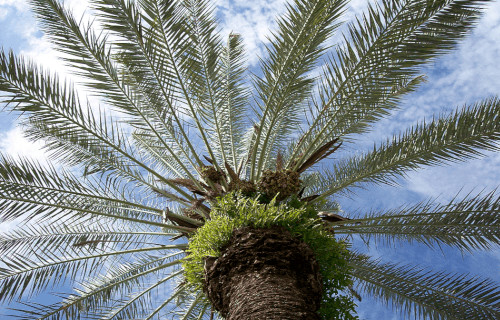
CCL: https://bit.ly/1p2b8Ke
Phoenix Plant Physical Description
The somewhat surprising Phoenix Plant also possesses yet another trait common to all species holding the name. That particularly distinct characteristic has to do with the blooms each of them produces, since they develop in the same manner.
Regardless of this shared trait, however, the various plants themselves have their own form of beauty, of course. For one thing, the flowers of the many plant, have their own highly distinctive visual appeal. This obviously stems from varying colors and shapes.
Firstly, while these blooms typically remain small, these most commonly develop in surprisingly large clusters. Secondly, in color, these flowers generally present a yellowish-brown and stay rather small. These usually average about 0.4 in (1 cm) in diameter.
The fruits of the varying forms of Phoenix Plant also share some traits. Among these is the fact that this part of the plant usually remains quite small, measuring about 0.4-2.8 in (1-7 cm) in length. The fruit is edible, though, and contains a high sugar content.
Added to this its the fact that most of the leaves appear as either reddish-brown, yellow or dark purple in color when mature. These fabulous plants also has a dioecious nature. Along with this, pollination is managed by both wind and insect activity.
- Kingdom: Plantae
- Phylum: Angiosperms
- Class: Monocots
- Order: Arecales
- Family: Arecaceae
- Genus: Phoenix
Phoenix Plant Distribution, Habitat, and Ecology
Since so many species go by the common name, the various types of the surprising Phoenix Plant inhabit an extremely wide habitat range. This includes one section of the world. That consists of the Canary Islands, parts of Africa, Crete, Turkey, China, and Malaysia.
The habitat types of the remarkable plant actually can be quite varied in nature. That’s due to the fact that these can include swamps, deserts, and mangrove forests. Most varieties grow medium to large in size, though a few known dwarf types also exist.
Most individuals display an incredible adaptation. Specimens usually grow under the shade of more dominant forest trees. The majority appear on slopes, and in warm, humid conditions. In the tropics, the vast majority of individuals occur at lower altitudes.
Finally, the various forms of the Phoenix Plant share one more trait. That pertains to its propagation. Each member of this amazing genus produces flowers and fruits on an annual basis. Reproduction also occurs by both seeds and vegetative shoots or bulbs.
Kurinji
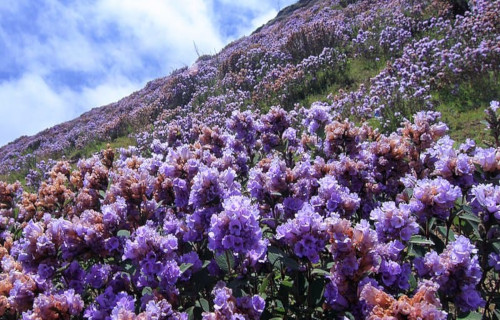
CCL: http://bit.ly/2zBWbKi
Kurinji Facts
- The final entry into this article about 6 Wondrous Woody Shrubs of Asia is the amazing plant known as the Kurinji.
- The visually stunning plant with the unique name has an amazing story to tell those who are willing to listen. Yet sadly, the plant also has a quite limited zone of habitation. This was not always the case for this incredibly beautiful plant, however.
- Moreover, this truly breathtaking species evolved as what science calls generally a plietesial. This somewhat complex term simply means that it developed into a long interval bloomer. In fact, the species only blooms once every 12 years.
- Some related species have bloom rates of every seven years, as well. Although this characteristic is amazing, the genetic trait appears in about 250 species in the genus. But sadly, once the magnificent plant blooms, it has reached the end of its life.
- The IUCN lists the beautiful Kurinji as Endangered, on its Red List. This could change for the worse in the near future. Unfortunately, only a portion of its quite tiny area enjoys protection. That’s true since it forms part of a sanctuary.
- Of all known long interval species, the Kurinji has been the most studied. Finally, because of its fascinating lifecycle, the Strobilanthes kunthiana, as it’s known to researchers, has been used by the local inhabitants as a way to mark their ages.
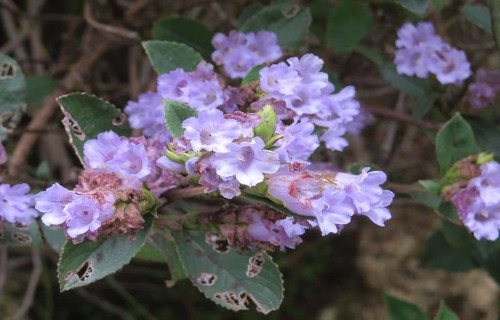
CCL: htp://bit.ly/2zBWbKi
Kurinji Physical Description
Notably, the Kurinji bears the classification of a shrub. But, the marvelous plant remains a relatively small example of one, compared to related species. That’s because most specimens of the shrub only reach a height ranging from 12-24 in (30-60 cm) in the wild.
As is easily apparent, the beauty of the plant comes largely from its stunning blooms. These magnificent yet delicate flowers usually appear in comparatively small clusters, though. In color, these blooms present a very specific range of colors.
This range of coloration most commonly consists of light to dark shades of the color purple. These delicate flowers also average about 1 in (2.5 cm) in length. In addition, the stalks of the magnificent Kurinji evolved a distinctly different trait of their own.
This statements stands on its own merit, since these display a reddish color, combined with a surprisingly smooth texture. In contrast, however, its leaves have a leathery texture and dark green color. Generally, these measure about 1.18 – 3.36 in (3 x 6 cm).
- Kingdom: Plantae
- Phylum: Angiosperms
- Class: Eudicots
- Order: Lamiales
- Family: Acanthaceae
- Genus: Strobilanthes
- Species: S. kunthiana
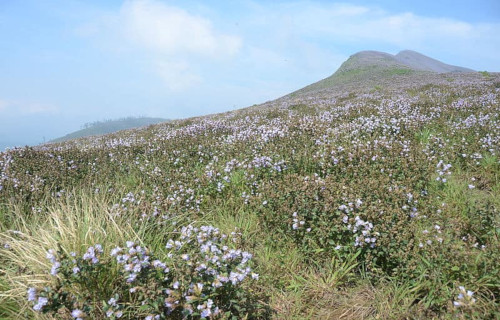
CCL: http://bit.ly/2zBWbKi
Kurinji Distribution, Habitat, and Ecology
Evolution provided the Kurinji with a restricted range of habitation. That holds true due to the fact that it apparently evolved solely as native to the country of India, in Asia. No evidence exists to support the possibility of it ever appearing anywhere else.
Even within this territory, the range of this Angiosperm has now become severely limited. As a result, the great majority of known specimens presently appear in the Western Ghats. A small number of plants nevertheless also exist in the Eastern Ghats, as well.
And once again, Nature gave the visually stunning plant known as the Kurinji yet another highly specific requirement for its flourishing. That remains true since it most commonly grows at high altitudes, ranging from 4,265 -7,874 ft (1,300 – 2,400 m).
This stunning work of evolution also has one more surprise for us. It nearly always appears on the sides of gently sloping hills within that range. Unfortunately, though, mankind has now taken away the great majority of its potential habitat in its range.
That’s true given the fact that the majority of the habitat remaining to it is now covered with numerous residences and plantations. In point of fact, only the Kurinjimala Sanctuary, which covers a scant 12.3 sq mi (32 sq km) offers the species secure protection.
6 Wondrous Woody Shrubs of Asia
We sincerely hope that you have completely enjoyed perusing this article about 6 Wondrous Woody Shrubs of Asia. These amazing plants certainly tickle the curiosity, don’t they? Unfortunately, though, many of them now find themselves facing great peril.
It remains up to all of us to do all that we can to protect these wondrous creations of evolution for our posterity. Each of them has their role to play in the ecosystems in which they evolved. Thus, they all, along with countless others, hold importance.
Check out our other articles on 5 Rare Mind-Blowing Cloud Types, Fabulous Herbaceous Plants Named After Animals, 8 Geological Wonders of North America
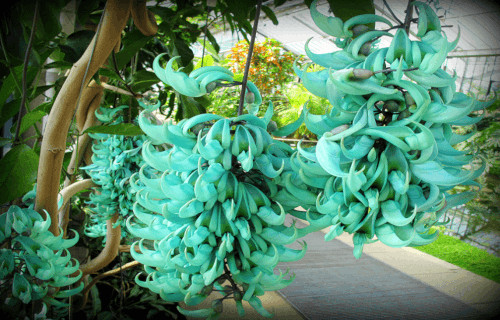
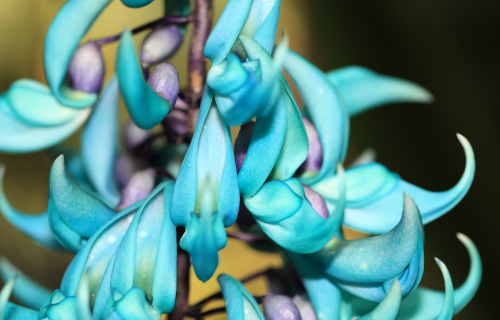
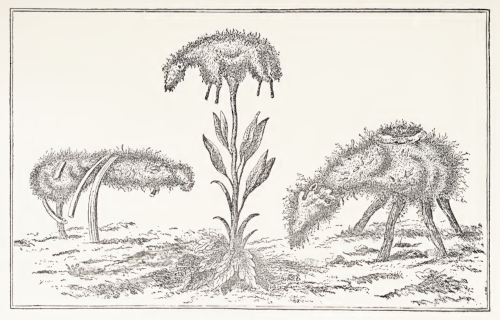
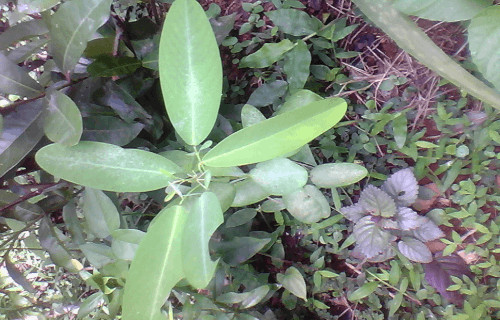
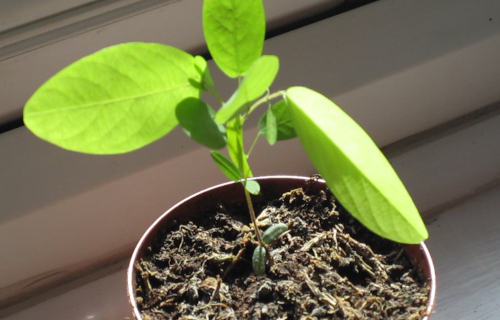
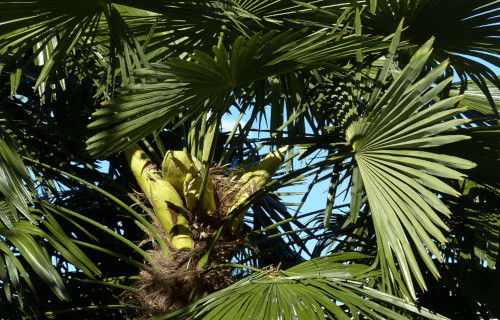
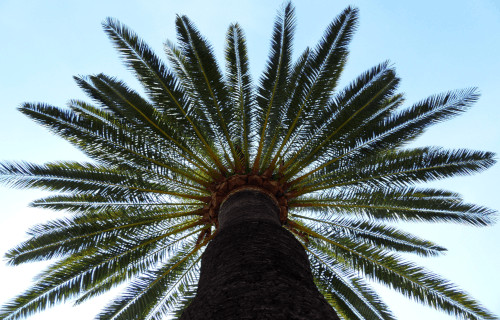









Leave a Reply